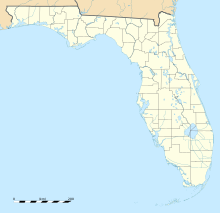Lake City Gateway Airport
Lake City Gateway Airport | |||||||||||||||
|---|---|---|---|---|---|---|---|---|---|---|---|---|---|---|---|
| Summary | |||||||||||||||
| Airport type | Public | ||||||||||||||
| Owner | City of Lake City | ||||||||||||||
| Serves | Lake City, Florida | ||||||||||||||
| Elevation AMSL | 201 ft / 61 m | ||||||||||||||
| Coordinates | 30°10′55″N 082°34′37″W / 30.18194°N 82.57694°WCoordinates: 30°10′55″N 082°34′37″W / 30.18194°N 82.57694°W | ||||||||||||||
| Website | LakeCityMunicipalFBO.com | ||||||||||||||
| Map | |||||||||||||||
 LCQ Location of airport in Florida | |||||||||||||||
| Runways | |||||||||||||||
| |||||||||||||||
| Statistics (2009) | |||||||||||||||
| |||||||||||||||
Lake City Gateway Airport (IATA: LCQ, ICAO: KLCQ, FAA LID: LCQ) is a city-owned, public-use airport located three nautical miles (6 km) east of the central business district of Lake City, in Columbia County, Florida, United States.[1] Formerly known as Lake City Municipal Airport,[2] it is included in the National Plan of Integrated Airport Systems for 2011–2015, which categorized it as a general aviation facility.[3]
History[]
NAS Lake City[]
The airport was originally built by the U.S. Navy during World War II to facilitate pilot training and named Naval Air Station Lake City. Commissioned in December 1942, NAS Lake City was located on the site of the Lake City Flying Club air field east of town. Established as one of several support facilities to NAS Jacksonville, NAS Lake City was used to train U.S. Navy and U.S. Marine Corps pilots in land-based PV-1 Venturas and PV-2 Harpoons. Maximum complement at the air station reached 290 officers and 1,150 enlisted personnel. As many as 200 additional officer and enlisted WAVES were stationed at NAS Lake City later in the war and served in air traffic control, meteorological services, administrative support, and aircraft maintenance. The airfield southeast of Lake Butler served as an outlying field (OLF) and Cedar Key, Alachua and Gainesville provided auxiliary fields. Regular military operations terminated in March 1946 and NAS Lake City was decommissioned as an active naval air station.[4]
Lake City Municipal Airport[]
The NAS Lake City property was deemed surplus and subsequently conveyed to the city of Lake City by the General Services Administration and renamed Lake City Municipal Airport. One of the first major tenants was Aero Corporation, which occupied the vacated military hangars and maintenance facilities, performing aircraft modification and rehabilitation during the 1960s, 1970s and 1980s, mostly U.S. military contracts supporting C-130 Hercules and P-3 Orion aircraft. Aero Corporation was subsequently acquired by TIMCO, which was then acquired by HAECO. the current tenant, which performs depot level maintenance on Boeing and Airbus commercial aircraft.
Lake City Gateway Airport[]
In 2011, the airport completed construction of a new 6,000 square foot terminal facility to support corporate business jet and charter airliner traffic. This also coincided with a name change in which the airfield was renamed Lake City Gateway Airport.[5][6][7]
Facilities and aircraft[]
Lake City Gateway Airport covers an area of 1,250 acres (506 ha) at an elevation of 201 feet (61 m) above mean sea level. It has two asphalt paved runways: 10/28 is 8,003 by 150 feet (2,439 x 46 m) and 5/23 is 4,000 by 75 feet (1,219 x 23 m).[1]
For the 12-month period ending September 8, 2009, the airport had 28,714 aircraft operations, an average of 78 per day: 86% general aviation, 9% military, and 5% air taxi. At that time there were 33 aircraft based at this airport: 67% single-engine, 18% multi-engine, 9% jet, and 6% helicopter.[1]
Although the U.S. Navy departed Lake City over 70 years ago, its comparatively long main runway (8,003 feet), operational Non-Federal Air Traffic Control Tower, and minimal air traffic makes it a popular location for transient Navy P-3C Orions from NAS Jacksonville and Air Force HC-130 Hercules and A-10 Thunderbolt II aircraft from Moody AFB to practice approaches and touch-and-go landings. The airport also has a Department of Defense into-plane refueling contract for Jet A fuel, otherwise known as "contract fuel," for military aircraft.
Besides typical general aviation use, the airport also hosts a major aviation industrial facility formerly known as Aero Corporation, first acquired by TIMCO Aviation Services, and now part of HAECO.[8] HAECO modifies and repairs large aircraft, such as commercial Boeing 727, Boeing 737 and various Airbus airliners, as well as military C-130 Hercules and P-3 Orion aircraft for US military and US civilian operators, as well as overseas military and civilian customers.[9]
References[]
- ^ a b c d FAA Airport Form 5010 for LCQ PDF. Federal Aviation Administration. Effective May 31, 2012.
- ^ "KLCQ – Lake City Municipal Airport – Lake City, Florida". FAA information effective 11 February 2010. AirNav. Archived from the original on April 7, 2010.
- ^ "2011–2015 NPIAS Report, Appendix A" (PDF). National Plan of Integrated Airport Systems. Federal Aviation Administration. October 4, 2010. Archived from the original (PDF, 2.03 MB) on September 27, 2012.
- ^ "Archived copy". Archived from the original on 2005-03-15. Retrieved 2009-01-17.
{{cite web}}: CS1 maint: archived copy as title (link) - ^ http://northfloridanow.com/lake-city-gateway-airport-year-in-review-p5252-92.htm
- ^ http://www.lcfla.com/index.php/departments/gateway-airport-klcq
- ^ https://s3.amazonaws.com/public-inspection.federalregister.gov/2016-07782.pdf
- ^ "HAECO – Press Releases – HAECO Completes Acquisition of TIMCO Aviation Services, Inc". haeco.com. Retrieved 2019-02-18.
- ^ http://www.timco.aero/
External links[]
- Lake City Gateway Airport at Lake City website
- Aerial image as of January 1999 from USGS The National Map
- FAA Airport Diagram (PDF), effective January 27, 2022
- FAA Terminal Procedures for LCQ, effective January 27, 2022
- Resources for this airport:
- FAA airport information for LCQ
- AirNav airport information for KLCQ
- ASN accident history for LCQ
- FlightAware airport information and live flight tracker
- SkyVector aeronautical chart for KLCQ
- Airports in Florida
- Transportation buildings and structures in Columbia County, Florida
- Lake City, Florida
- 1942 establishments in Florida
- Closed installations of the United States Navy
